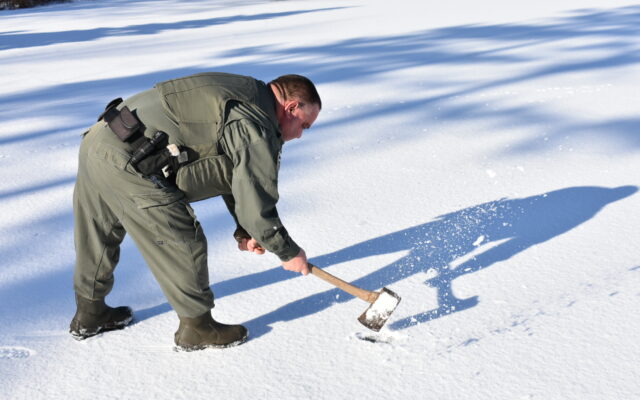
Checking the ice before you step onto Maine’s lakes and ponds can save your life
By Pete Warner, Bangor Daily News Staff
It is an exciting time of year for Mainers who want to get out on the ice.
Lakes and ponds are already frozen over in places, while other bodies of water have no ice whatsoever.
That’s why it is crucial, especially early in the season, to use extreme caution before heading onto “hard water” for ice fishing, snowmobiling, skating and other activities. Failure to recognize unsafe areas could lead to a life-threatening fall through the ice.
To demonstrate the startling range of conditions as lakes and ponds begin to freeze, Game Warden Rick Ouellette was kind enough last week to take the time to talk about ice safety.
We started at Davis Pond, along Route 9 in Eddington. Ouellette, a 20-year veteran of the Maine Warden Service, walked down the bank to the edge of the pond, which appeared frozen and was covered by a thin layer of snow.
He used a small ax to sample ice along the shore, which he discovered to be 8 or 9 inches thick. That’s plenty of ice to support people and equipment.
Warm-water ponds like Davis Pond are different from so-called cold-water lakes and ponds, which have more water flow, Ouellette said.
“These lakes will freeze first and they’ll freeze harder than a lake that’s spring-fed,” Ouellette said.
“I always tell people, check ice conditions a lot. Walk a little ways, because you’ve got inlets and outlets, different currents.”
Extra vigilance is needed around rocks, which absorb heat from the sun and melt away ice close to them, he said.
An ice fisherman appeared on the lake a few hundred yards away, prompting Ouellette to do a license check. The ice where the man had drilled holes and placed his traps was about 6 inches thick.
Our ride then took us 8 or 9 miles away, as the crow flies, to the east side of Beech Hill Pond in Otis. There was barely a skim of ice along the shoreline for a distance of 10 or 15 feet and then it was all open water.
It was a stark contrast to the ice we had seen 20 minutes earlier on Davis Pond.
We looped down around the far southern tip of Beech Hill and past the public beach, onto the west side of the pond. In a narrow cove, we could see ice extending for hundreds of yards.
But it was obvious by the dark ribbons of color that there was open water just beyond. Ouellette again carefully chopped some small test holes and quickly discovered that the good ice in this spot didn’t extend far.
Barely 10 yards out, it was only 2 inches thick. He went no farther.
“You go much further out, you’d be in trouble,” Ouellette said, stressing the need for people to do frequent testing of the ice thickness.
“The ice got thinner and thinner the further we got away from the shoreline. A spot like this, you’d want to use extreme caution if you were trying to ice fish,” he said.
There are many factors affecting the thickness and quality of ice on Maine’s lakes and ponds. Up north, they usually freeze more quickly and securely than in the southern part of the state.
That said, warm weather and rain can quickly turn safe ice into potentially dangerous conditions.
“There’s no doubt that what’s safe today might not be safe tomorrow,” said Ouellette, who suggested people who live on lakes and ponds often can provide important information to those who might be unfamiliar with an area.
“Some locals know where it’s never safe,” Ouellette said. “There’s places on some lakes that never freeze.”
Although 12 to 15 inches of ice can usually support a medium-sized truck, the Maine Department of Inland Fisheries and Wildlife strongly recommends that people not drive passenger cars or trucks on the ice. Ouellette has been called to several situations over the years involving snowmobiles and vehicles that broke through the ice, resulting in injuries, loss of property and even death.
Many situations when vehicles break through ice occur at night when visibility is limited and pressure ridges and areas of thin ice or open water can’t easily be detected.
And just because there are 3 or 4 inches of ice doesn’t mean it’s ice that can support weight and activity.
“If it’s not good, blue, solid ice, it’s not weight-bearing ice,” said Ouellette, who urged caution with areas where water is showing through or there’s slush or skim of thin, crusty ice on the top.
We finished by driving around the rest of the way around the pond. There were patches of sketchy looking ice, but most of the surface was open water.
Fisheries and wildlife department suggests carefully checking the ice with a chisel, ax or ice auger. It should be at least 4 to 6 inches thick. The agency suggests carrying a set of easily accessible ice picks for use to grip the ice in case you should fall through.
The department and warden service also encourage outdoors enthusiasts to let a family member or friend know where you’re going fishing, snowmobiling or hiking in case you run into trouble and need help.